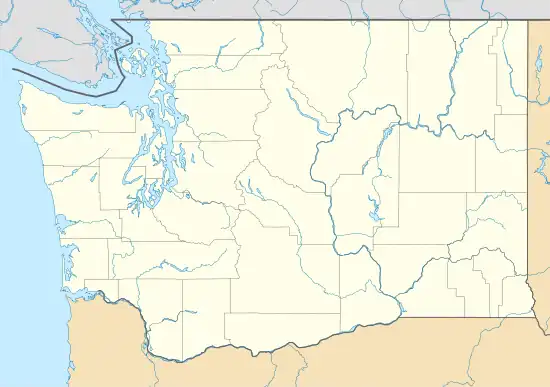Mineral City, Washington
Silver City | |
|---|---|
 A 14-foot diameter fir tree at Mineral City | |
 Mineral City, Washington | |
| Coordinates: 47°57′03″N 121°26′08″W / 47.95083°N 121.43556°W | |
| Country | United States |
| State | Washington |
| County | Snohomish |
| Settlement of Silver City | 1873 |
| Establishment of Mineral City | 1892 |
Mineral City is a ghost town in Snohomish County, Washington.
Location
Mineral City is situated on Silver Creek, four miles north of Galena. The Silver Creek drainage area is rugged and difficult to navigate.[1] Monte Cristo is accessible to the north via Poodle Dog Pass.[2] Mineral City was established in 1892 on the site of a previous settlement, Silver City, which was established in 1873 by Theron Ferguson (1840-1918), but abandoned by the 1880s.[3]
History
Mineral City lies on a speculated route between the territory of the bəsx̌əx̌əx̌alč band of the Skykomish, based in Index, and the Sauk to the north.[4]
The first mining claims in the area, the Silver Creek Mining District, were located by George White and Hill Tyler in 1871.[5] Hans Hansen recorded the Norwegian Claim along Silver Creek in 1874.
Monte Cristo stakeholders considered building a railway passing through Mineral City to Monte Cristo via a tunnel under or switchback over Poodle Dog Pass, but this was ruled out as too expensive.[6] Later, in 1935, a road was proposed by the Works Progress Administration (WPA) from Mineral City to Monte Cristo.[7] However, this road was never built.
The Silver City Mining Company's boarding house served as a voting precinct in the 1880 presidential election.[8]
Prospector Joseph "Joe" L. Pearsall (1855-?) discovered the more successful Monte Cristo site via Mineral City.[9][10]
The plat for Mineral City was filed on June 20, 1892 by Elisha Hiram Hubbart (1839-1895). The town site consisted of 15 blocks, and was located in the Anna Quartz mining claim.[11] At its peak it had 2 hotels, 2 saloons and 2 stores.
After a 1980 storm, a quarter-mile length of the ridge between Galena and Mineral City collapsed, washing out the road. The route remains impassable by vehicles.[12]
References
- ↑ Broughton, W. A. (1942). "Inventory of Mineral Properties in Snohomish County, Washington" (PDF). Washington State Department of Natural Resources. Olympia, WA: State of Washington Department of Conservation and Development. p. 27. Retrieved July 10, 2023.
- ↑ Woodhouse, Phil; Daryl, Jacobson; Bill, Petersen (2000). The Everett & Monte Cristo Railway. Arlington, WA: Oso Publishing Company. p. 6. ISBN 0964752182.
- ↑ "Mineral City Silver Creek Mines". Ghost Towns of Washington. Retrieved July 9, 2023.
- ↑ Hollenbeck, Jan L.; Moss, Madonna (1987). A Cultural Resource Overview: Prehistory, Ethnography and History: Mt. Baker-Snoqualmie National Forest. United States Forest Service. p. 169. OCLC 892024380.
- ↑ Church, S.E; Tabor, R.W.; Johnson, F.L. "MINERAL RESOURCE POTENTIAL OF THE GLACIER PEAK ROADLESS AREA, SNOHOMISH COUNTY, WASHINGTON" (PDF). United States Geological Survey. pp. 7–10. Retrieved July 9, 2023.
- ↑ Woodhouse, Phil; Daryl, Jacobson; Bill, Petersen (2000). The Everett & Monte Cristo Railway. Arlington, WA: Oso Publishing Company. p. 5. ISBN 0964752182.
- ↑ "MINE-TO-MARKET ROADS PLANNED IN GRANITE DISTRICT". Snohomish County Forum. August 1, 1935. p. 1. Retrieved August 24, 2023.
- ↑ Whitfield, Wm. (1926). History of Snohomish County, Volume 1. Pioneer Historical Publishing Company. p. 102. hdl:2027/wau.39352020206801.
- ↑ Riddle, Margaret (August 16, 2006). "Joseph Pearsall stakes the first mining claim in Snohomish County's Monte Cristo area on July 4, 1889". HistoryLink: The Free Encyclopedia of Washington State History. Retrieved July 9, 2023.
- ↑ "Welcome Guide 1996". Archive in a Box. Granite Falls Historical Society. 1996.
- ↑ Whitfield, Wm. (1926). History of Snohomish County, Volume 1. Pioneer Historical Publishing Company. p. 808. hdl:2027/wau.39352020206801.
- ↑ "A devastating flood isolates Monte Cristo (Snohomish County) and begins a new era on December 26, 1980. - HistoryLink.org". www.historylink.org. Retrieved December 21, 2023.
